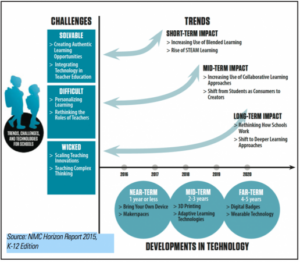This summer the New Media Consortium (NMC), together with the Consortium for School Networking (COSN), released their annual K12 Horizon Report, a report that is very informative for manufacturers and integrators in the display industry. This report has been around a long time. With more than 13 years of research and publications, it can be regarded as “the world’s longest running exploration of emerging technology trends and uptake in education.”

The full report can be accessed here. The following chart helps lay out the big ideas in this report.
In last month’s article, I outlined and parsed some of the emerging developments highlighted in the report. In this piece, I will cover some of the key trends being predicted for the educational market. Again, with full disclosure I must mention that I served as one of the 56 panelists who developed this report over many months. My findings and commentary follow.
Important observable trends in technology for K12 schools world-wide.
Short-term impact
- Increasing use of Blended Learning
- Rise of STEAM Learning
Both of these trends are a big deal in K12 education. Over the last three years, these have risen in popularity to secure a large part of the mindshare at educational conferences. Display industry leaders ignore these trends at their own peril.
Blended learning is a term that describes the ability to mix online learning with face-to-face classrooms to some degree. From hybrid online teaching, to flipped learning, to Internet-based assignments—the examples are diverse—blended learning is the way many teachers are shifting their teaching practice. Being fluent with this terminology, exampling the use of your display technology with appropriate use cases, and understanding the nuances of blended learning delivery will play much to your advantage. In my last two conference exhibit hall walkthroughs, I slowly realized that many vendors were representing their technology using an old paradigm—showing display technology in the same way these vendors were taught. Times are changing. Blended learning is the new realty. You had better get this one right. Or you may not be excel in your outreach to educators.
STEAM refers to science, technology, engineering, arts, and mathematics. This trend speaks to the workforce needs of modern society. STEAM is a big deal in schools. It often has its own funding. Districts are steadily moving to create focus or magnet schools with a STEAM emphasis. Many schools already have STEAM initiatives within their program. The critical issue for the display industry is that you speak to this meme with your offerings—that your message, your sales collateral, your displays, your partners, and your conversations can effectively reach this high-interest market in today’s schools.
Mid-term impact
- Increasing use of collaborative learning approaches
- Shift from students as consumers to creators
For an understanding of the collaborative learning meme, and how it is playing out in education, see my previous Display Daily piece entitled “Huddle Up.” This article speaks directly to the display industry in terms of the growing phenomenon in schools of collaborative learning.
More and more, teachers are shifting their thinking away from students as consumers of technology. Instead, educators value students being able to produce creatively with technology. Return to my recent exhibit hall walkthroughs at educational conferences. Almost every booth is focused on pouring information into the minds of empty-vessel students, using displays, computers, projectors, or the technology du jour. It truly strikes me as anachronistic. Actually, it’s the pathway to extinction, because educators are making the shift to “students as creators” with technology. What message does your booth suggest? Your sales literature? Can you speak the educators’ language of ‘producer’ versus the past paradigm of “consumer”?
Long-term impact
- Rethinking how schools work
- Shift to “Deeper Learning” approaches
The shift to deeper learning signals that it’s time to move the industry marketing vernacular used to communicate with educational customers beyond the typical low-lying fruit. No more references, please, showing how your product improves retention. We don’t care. No more exclamation of the “wow factor” your product offers. We care more about results. No more constant harping about your product’s ability to motivate children. Motivation is a nice contributing outcome, but we need deeper and more results-oriented learning. In many schools, the pressure is really on. Beyond using more meaningful language, the display industry needs to start creating pilot and showcase projects in schools that demonstrate the real learning possible with great visual tools and strategies.
In my final installment, next month, I am going to continue this discussion by addressing some of the challenges and roadblocks the 2015 K12 Horizon report predicts. Stay tuned. – Len Scrogan

